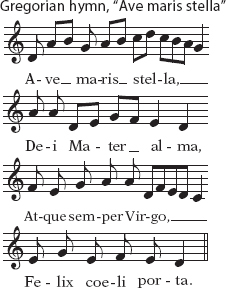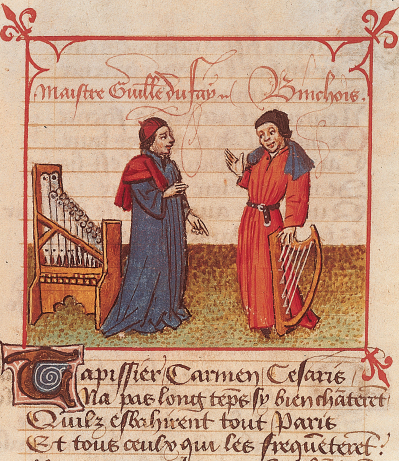Guillaume Dufay (c. 1400–1474), Harmonized hymn, “Ave maris stella”
Guillaume Dufay (or Du Fay) was born and bred in the north of France near modern Belgium, a region that supplied the whole of Europe with musicians for many generations. For over twenty-
Dufay’s “Ave maris stella” is a homophonic setting of a Gregorian hymn, one of the most tuneful of plainchant genres. A short tune is sung through many stanzas, followed by an Amen — much like a modern hymn, in fact. One of the loveliest of Gregorian hymns, “Ave maris stella” was also one of the best known, because it was addressed to the Virgin Mary and sung on all of the many special feasts in her honor, and on most Saturdays, too. Note how line 1 contains the words AVE MARI(s stell)A — “hail, Mary.”

“Ave maris stella” is in the D (Dorian) mode. You may be able to hear that the third note in the tune (the sixth note of the scale) is higher than would be normal in the modern minor mode. The hymn itself has six or seven stanzas; Dufay set only the even-
His music for stanzas 2, 4, and 6 is the same each time — almost entirely homophonic and quite suave. The top voice sings a paraphrased, somewhat longer version of the hymn tune, as shown below, where the dashed lines mark the notes taken directly from the chant, shown screened in blue. The embellishment consists of a few extra notes and extensions, with the free rhythm of Gregorian chant channeled into a graceful triple meter.

“Ave maris stella” counts as a rather simple composition for Dufay, whose fame was and is based on longer, more elaborate pieces; he wrote some of the first polyphonic Masses, for example — the important genre we take up next. Still, plainsong harmonizations make up an appreciable proportion of his output, and they show the new Renaissance attitudes with particular clarity.
LISTEN
Dufay, “Ave maris stella”
| STANZA 1: Plainchant |

Dufay and another fifteenth-
|
||
| 0:00 | Ave maris stella, Dei Mater alma, Atque semper Virgo, Felix coeli porta. |
Hail, star of the ocean, Kind Mother of God, And also still a virgin, Our blessed port to heaven. |
|
| STANZA 2: Dufay’s paraphrase | |||
| 0:22 | Sumens illud Ave Gabrielis ore, Funda nos in pace, Mutans Hevae nomen. |
May that blessed “Ave” From Angel Gabriel’s mouth Grant us peace, Reversing the name “Eva.” |
|
| STANZA 3: Plainchant | |||
| 1:13 | Solve vincla reis . . . | ||
| STANZA 4: Paraphrase | |||
| 1:35 | Monstra te esse matrem . . . | ||
| STANZA 5: Plainchant | |||
| 2:26 | Virgo singularis . . . | ||
| STANZA 6: Paraphrase | |||
| 2:48 | Sit laus Deo Patri, Summo Christo decus, Spiritui Sancto, Tribus honor unus, Amen. |
Praise be to God the Father, To Christ on high, To the Holy Spirit: Three honored as one. Amen. |